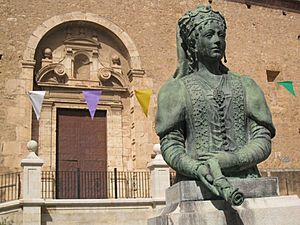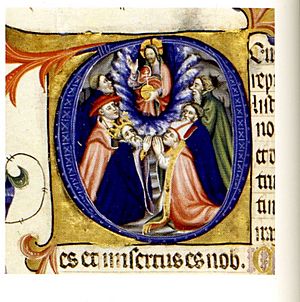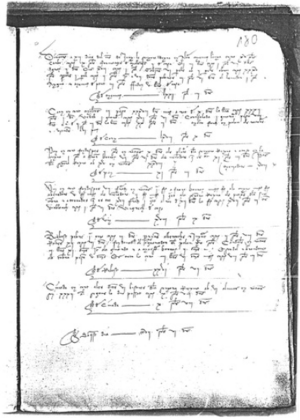Maria de Luna facts for kids
Quick facts for kids Maria de Luna |
|
|---|---|
 |
|
| Queen consort of Aragon | |
| Tenure | 1396–1406 |
| Born | 1358 |
| Died | 20 December 1406 Villarreal |
| Spouse | Martin I of Aragon |
| Issue | Martin I of Sicily |
| Father | Lope, Count of Luna |
| Mother | Brianda de Got |
| Religion | Roman Catholicism |
Maria de Luna (born around 1358 – died 1406) was a powerful queen of Aragon. She was married to King Martin I of Aragon. When her husband became king in 1396, she became queen consort and held this title until her death in 1406. In the first years of Martin's rule, Maria acted as a temporary ruler (called a regent) in Aragon. This was because her husband was busy with matters in Sicily, another kingdom he also claimed.
Maria was the daughter and heir of a very important Aragonese noble, Lope de Luna, who was the first Count of Luna. Her mother was Brianda d’Agout from Provence.
Maria was promised to Martin (who would later become King of Aragon) when she was a child. She grew up in the royal court with Martin's mother, Queen Eleanor of Sicily. Maria and Martin married in Barcelona on June 13, 1372. She became queen when Martin took the throne in 1396. Since Martin was in Sicily at the time, Maria became regent. She ruled alongside the Queen Dowager Violant of Bar and Matthew, Count of Foix until Martin returned in 1397.
Maria was very active in politics and had a big impact on the government and society. Some people even thought she was a better ruler than Martin! She helped poor people with money, managed taxes, and welcomed Jewish and Muslim refugees. She also tried to stop fights between noble families. Maria even wrote directly to Antipope Benedict XIII (who was from Aragon) to suggest banning unfair laws. People described her as wise, fair, kind, and religious, but not extreme. She loved music and books but didn't care much for fancy displays or luxury.
Contents
Early Life of Maria de Luna
Maria was born in 1358. She was the oldest child of Count Lope de Luna and his second wife, Brianda d’Agout. Her family was one of the most important in Spain. Many family members held high political and religious jobs. For example, Lope Fernandez de Luna, Archbishop of Zaragoza and Antipope Benedict XIII were her relatives. Her father helped the family become even more powerful. He was very loyal to the Aragonese Crown and was rewarded by being knighted and later made a count. After this, her family was the only one in Aragon with a member who reached the rank of "count."
Maria's father's first marriage didn't have any children. So, Maria was officially named his only heir shortly after she was born. Even though Lope had an older son who was not born in wedlock, and later another daughter after his death, Maria's status as the main heir was never changed.
Her Betrothal
When Lope died in 1360, two-year-old Maria became one of the richest landowners in Spain. Because of this, King Peter IV of Aragon quickly noticed her. He wanted to arrange a marriage for his younger son, Martin. Maria's mother and her powerful relative, the Archbishop of Zaragoza, handled the marriage talks.
The agreement was made in the summer of 1361. It said that Maria would stay with her family until she was eight. Then, she would move to the court of her future mother-in-law, Eleanor of Sicily. She would marry Martin when she turned fourteen.
Life at the Royal Court
It seems Maria moved to the royal court earlier than planned. She appears in Queen Eleanor's records as early as 1362. This suggests she moved to court around age four or five. So, she grew up very close to her future husband. We don't have much information about her childhood at court. However, she likely received a very good education. This is shown by her writing skills, the books she owned, and how quickly she managed her own lands when she grew up.
Marriage and Royal Favor
On June 13, 1372, Maria and Martin were married. The wedding took place at the Church of Santa Maria del Mar in Barcelona. Many important nobles and the King were there. In the years after, Maria was mostly busy having children, managing her household, and taking care of her personal lands.
Maria and Martin were very favored by the King. In the fifteen years after their marriage, King Peter gave his younger son many important jobs and lands. When King Peter died on January 5, 1368, his oldest son became King John I. Within weeks, John made his brother Martin the Duke of Montblanc. Before this, the only other duchy in Aragon was Girona, which was only for the heir to the throne. This was a huge honor for Martin and for Maria, who became the new duchess.
Maria's Reign as Queen
Serving as Regent
In 1396, King John died without a child to take his place. The throne of Aragon then went to John's younger brother, Maria's husband Martin. But Martin was away fighting a war in Sicily. He wouldn't hear about his brother's death for several weeks. Maria was in Barcelona, so she was declared queen. She was also appointed to act as the Crown's temporary ruler (lieutenant-general) while her husband was away.
Maria's change from duchess to queen was difficult. There was a lot of unrest and uncertainty. The previous queen, Violant of Bar, tried to keep power. She claimed she was pregnant with John's child. Many nobles were unsure about supporting Maria and Martin right away, just in case Violant had a son. At the same time, John's daughter, Joanna de Foix, tried to claim the throne for herself. Her husband, Matthew de Foix, and his powerful family supported her.
During this time of trouble, Maria tried to get Martin to come back to Aragon to help her stabilize the kingdom. But Martin didn't want to leave his military campaign. He refused his wife's requests for many months. Maria then claimed to be worried about Violant's health during her supposed pregnancy. She had Violant moved to one of her own castles, separating her from her supporters. Soon enough, Violant's pregnancy was shown to be fake.
Maria then gathered an army. She put Violant and Matthew's suspected supporters in prison. She also took away their lands in Aragon. After some back-and-forth fighting with Joanna and Matthew, Maria finally defeated them. Martin returned home soon after.
Martin's Return
When Martin returned to Aragon in 1397, many months into his reign, Maria's time as lieutenant-general ended. However, her importance over the next thirteen years (until her death) remained very high. She had a close relationship with her son, Martin, and gave him important advice during his short rule over Sicily. Her husband also clearly saw her as a key advisor and supporter. Their many letters to each other show this strong relationship.
Her Faith and Beliefs
Maria de Luna believed in something called the Devotio Moderna. This was a way of Christian worship that became popular in the Middle Ages. It focused on praying aloud and thinking deeply about the life and actions of Jesus. Joan Eiximenio was her personal religious advisor. He translated a book called "Arbor vitae crucifixus" into Catalan. This project made Eiximenio realize that more religious texts should be translated into Catalan, especially for the 40 days of Lent. During Maria and Martin's reign, he put together "Quarentena de contemplacio," a collection of prayers and meditations for Lent.
Maria de Luna also worked with the Franciscan friars. She gave money to help build their monastery of the Holy Spirit (the Monasterio del Santo Espíritu).
Daily Life and Management
Records from Maria de Luna's court show details about the food they ate, what they bought, and how food was prepared. These records help us understand daily life in Spain during the early 1400s. Compared to other royal households of that time, Maria de Luna's records are very detailed. They describe specific dishes cooked for the queen, how much food each person ate, the weight of animals used for meat, and how much wheat was used for bread.
Just like the king, every meal Maria de Luna ate was a public event. What she ate, drank, and how she behaved showed her status. It also made her a role model for those around her. Each royal household had its own customs. Maria de Luna's household was known for "her close relationship with religious orders and with charity." It was also known for how much attention she paid to medical advice, because she often had poor health. For example, even during Lent, she ate poultry because her doctors said it would help her stay strong when she was sick.
Maria de Luna's records from 1403 also show how grand the court was in Valencia. The wide variety of foods available also showed the queen's high status. An analysis of these records explains that "the image that the queen projected to her guests, and in general to her subjects; food and the general levels of display that went with it on a daily basis were among the principal elements of prestige available to her." The farms around Valencia could provide many different foods to the city's market. Even when Maria de Luna traveled to smaller places in 1403, her court still had plenty of food. This suggests that suppliers might have traveled with Maria de Luna.

Her Political Actions
Helping Minority Groups
In 1398, Maria de Luna gained control over seven Jewish and six Muslim communities. She became responsible for the aljama, which was the official term for these minority groups. She had power over the Jewish community of Morvedre, a town north of Valencia. She made rules that helped this community recover from difficult times. Morvedre had suffered many violent attacks. In 1348, troops invaded it, and rebels attacked it again. From 1363 to 1365, soldiers from Castile occupied the town. In 1391, the Jewish people of Aragon were in danger when a preacher named Vincent Ferrer encouraged violence against them.
As the Jewish community of Morvedre was recovering after the problems of 1391, they faced money troubles because many refugees came in. Maria de Luna decided not to make them pay the higher taxes that King Peter III had set. Instead, she let them pay only a quarter of that amount, just as King John I had done. In 1401, Maria also used her royal power to stop the local authorities (called jurats) from taxing the Jewish community. The local authorities tried to tax Jewish property, even though Jews had always paid their taxes directly to the monarchs.
Maria again went against the local authorities' opinions in 1403. Her husband, Martin, passed a law that would force Jews in the kingdom to wear large yellow and red badges. Maria disagreed with this. She made sure the law was not enforced in Morvedre or in Onda, a place where many Jews traded. Although Jews had been required to wear red badges since 1396, these were smaller and less noticeable than the new badge, which was meant to clearly separate Jews from Christians.
Maria de Luna's policies towards Jewish people seemed to be driven by both practical reasons and a general concern for their well-being. When Maria found out that Jacob Façan, a Jewish man who had given a lot of money to the throne, was being investigated for not being faithful to the Catholic religion, she stepped in to protect him.
To lessen the effects of religious investigations (inquisitions), she first tried to bargain. She agreed that some Jews might deserve punishment. But she wanted to control how these investigations were done. However, Maria's stance did not stop all investigators from trying to prosecute Jews. When a case came up against Jewish women who supposedly had given up their previous conversion to Catholicism, she forced the bishop who had imprisoned the women to let them go. She realized the case had gone on too long and went against her belief that "our rights and our vassals...will remain whole."
Economic Policies
When Martin joined Maria in May 1397, she stopped being the lieutenant of Aragon. However, she continued to play an important role as queen consort. In 1402, she tried to stop the unfair treatment of the remença, who were rural farmers in Catalonia. Their noble landlords were exploiting them, and Maria called these practices "bad habits" (malos usos). Maria de Luna tried to get support from Pope Benedict XIII on this issue, but she was not successful.
Her Legacy and Recognition
In the 1390s, a Franciscan religious scholar named Francesc Eiximenis changed his earlier work, the Llibre de les dones, for Maria de Luna. He wrote for her the Scala Dei ("Ladder of God"). This was a religious text with prayers written in Catalan (and some notes in Latin). He gave it to her shortly after she became queen. Eiximenis didn't just influence Maria de Luna through his writing. He was about thirty years older than her and knew her since she was a child. He acted like a father figure to Maria and Martin. He was never an official advisor, but he was in charge of carrying out Maria's will after she died.
The Scala Dei included the Ten Commandments, essays on the good qualities of women and queens, the seven deadly sins, and writings on repentance and deep thought. Eiximenis hoped that the Scala Dei would encourage the Crown of Aragon to join the reform movement of Observant Franciscanism, which was just starting. Maria de Luna's reputation when she became queen was very different from that of Violant de Bar. The Franciscans saw Violant as "too silly, too French, and shamefully ignoring state affairs."
Maria de Luna likely asked for two copies of the Scala Dei for herself, one in 1397 and another in 1404. As Eiximenis explained in the introduction to his work: "Most High Lady, many times your great Ladyship has encouraged me, for the improvement of your spiritual life, to prepare as you request some little book from which you might derive some guidance or light to better guard you from any offence to God, and that you might most aptly enjoy in all virtue, and better please God: for which, Most High Lady, I—wishing to satisfy your pious intentions, and for the sound increase of your devotion—have assembled the following book."
The way the Scala Dei was structured and its message reflected common religious writings meant for women in the later Middle Ages. At that time, women were thought to be easily overcome by strong emotions. So, books on behavior and devotion were meant to calm them. They also aimed to guide their strong feelings towards more healthy and religious goals.
Eiximenis's ideas about gender influenced how he presented Maria de Luna in the Scala Dei. For Eiximenis, "a woman's place was built around and limited to the home, the family, and the body." This meant that instead of showing her as a queen-lieutenant and governor, he put her in a secondary, dependent role. Eiximenis believed that queens had a different and less important status because they were female:
"[The queen] owes it to her husband at all times to conserve the peace in the kingdom and ensure swift, righteous, and clear justice to their peoples, and not under any circumstances act as a tyrant, but rather to show herself likable and dear to her people, and take counsel from a small group chosen from among them, and fearing God, and eschewing greed, and who are committed to the common good and not their own affairs."
Like other religious texts from the late Middle Ages, Eiximenis's rules stated that "the queen is to pray with humility, to kiss the ground before the image of Christ, to kneel, and to look at him with humility and reverence. Praying alone in a private room or chapel, at night or early in the morning, served not only to underline the humility and authenticity of devotion, but quite simply to ensure that she would not be interrupted."
Nuria Silleras-Fernandez, in her book Chariots of Ladies, suggests that the Scala Dei and Maria de Luna's personal relationship with Eiximenis greatly shaped her queenship and her later reputation. She did, in fact, start the Observant Franciscan movement in her region. Silleras-Fernandez argues that "Eiximenis inspired Maria to cultivate became the kernel of her royal persona, or, as she preferred to call it in her letters, her 'queenly dignity' (dignitat reginal)." Also, he "coached her on how to project an image that enabled her to exercise power without upsetting contemporary sensibilities regarding gender roles."
Maria's Children
Maria and Martin had four children. Sadly, three of them died when they were very young:
- Martin I of Sicily
- James (born 1378)
- John (born 1380)
- Margaret (born 1384 or 1388)
See also
 In Spanish: María de Luna para niños
In Spanish: María de Luna para niños



